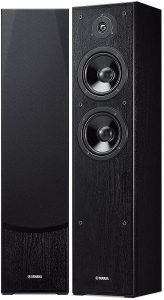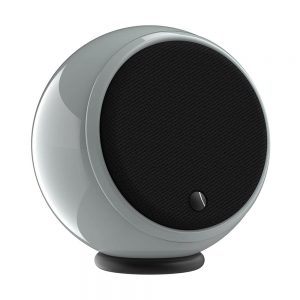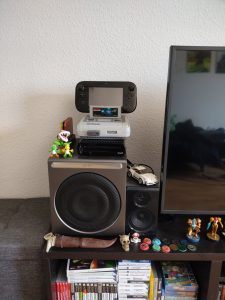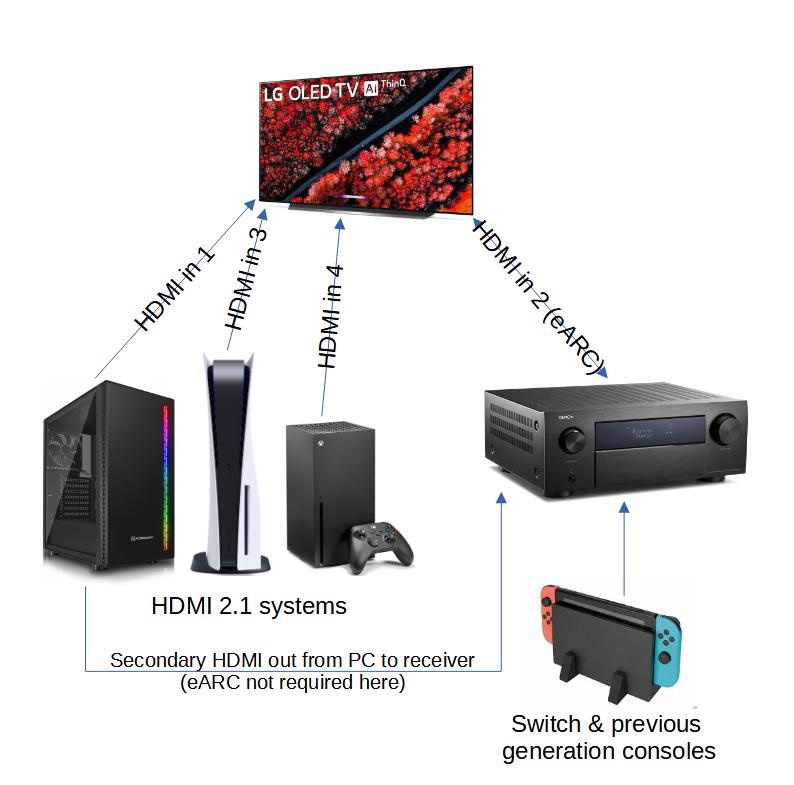AV Guides, Games Room Equipment, Games Rooms, Howto & Guides
Building our New Games Room – Part 5 – Gearing up for AV
Welcome to the next instalment of our new games room write up. When I had started these articles I planned to do at least one a month, I’m further behind than a government project!
This time we are going to be talking about the speakers and AV receiver we chose for our games room. What once was the simple matter of getting a pair of speakers and a decent amp (or even just making do with the speakers in your TV) is made somewhat more complex thanks to the different HDMI standards now on the market. This means that, depending on your setup at least, accommodating something like a PS4 Pro can have quite different considerations to accommodating a PS5.
HDMI 2.1 – A game changer?

With the release of The PS5, Xbox Series X/S and the latest PC graphics cards, HDMI 2.1 is well and truly here. HDMI 2.1 adds two important features for gamers, namely 120hz support and support for variable refresh rate. 120hz support allows games to basically double their refresh rate, showing 120 frames per second instead of 60, for smoother visuals and potentially less input lag.
Variable refresh rate, also known as VRR, has been available on PC monitors via the competing standards of G-Sync and Freesync, for some time, but now with HDMI 2.1 the feature has come to consumer televisions too. As the name suggests, VRR allows the display to change the refresh rate in real time, adapting to what is happening on the game you’re playing. Should you reach a point in your game where your PC or games console can’t keep up with a 60 or 120 frames per second refresh, VRR will allow the display to temporarily lower the refresh rate instead of tearing the image, stuttering or dropping down to a much lower frame rate.
Both these technologies are highly desirable for gaming and if you plan to have a next generation system in your setup, you should certainly plan to accommodate them. However, that is easier said than done.
HDMI 2.1 – A pain in the posterior?
You might imagine that adding HDMI 2.1 to your setup is as straightforward as adding any HDMI device but unfortunately you would be wrong. HDMI 2.1 is such a new standard that actually finding compatible equipment is often impossible. HDMI switches, splitters and other devices not specifically designed for the HDMI 2.1 standard will not work. While you will most likely get a picture when using your devices with older HDMI equipment, you won’t be able to access HDMI 2.1 exclusive features like 120hz or variable refresh rate.
Even if you have the budget to upgrade, the number of HDMI 2.1 compatible switches on the market right now is approximately zero. When it comes to AV receivers, there are only a handful that promise HDMI 2.1 compatibility at all, and even fewer that have more than a couple of HDMI 2.1 compatible ports. If you’re a streamer or like to capture gameplay footage using a HDMI splitter with your capture card and TV, you should note that it may even be impossible to split a HDMI 2.1 signal, now or in the future, when said signal is using the variable refresh rate feature.
HDMI 2.1 is so new that something as fundamental as finding HDMI 2.1 compatible cables can be a chore. While popular retailers like Amazon do generally stock certified compatible cables now, finding a compatible cable for a longer run is still difficult. Your existing cables might work, but you will need to thoroughly test them with a 120hz 4K software title for at least 30 minutes to be sure. To add more confusion, you may find that certain premium grade longer length HDMI 2.0 cables, the kind you might reasonably expect to be more likely to handle HDMI 2.1, may fail with HDMI 2.1 signals altogether. This is especially true when the cable in question has some kind of signal boosting technology baked into it.
What are your options if you want to incorporate a PS5, Xbox One and PC in your setup? You can splash out on a HDMI 2.1 compatible receiver, like the Onkyo TX-RZ50. However, you might already have a receiver you’re otherwise perfectly satisfied with. Alternatively, you can take advantage of another HDMI 2.1 feature, namely eARC.
eARC of the covenant
eARC stands for “enhanced audio return channel” and it provides a means of sending audio data back along a HDMI cable to a receiver. Using eARC, you can connect your HDMI 2.1 console or PC directly to the TV to take advantage of VRR and 120hz etc. Your TV will then send the sound data through another HDMI cable to your receiver. This can also be useful if you have a smart TV and use apps for media streaming.
What if your receiver doesn’t support HDMI 2.1 eARC correctly? Many receivers that don’t implement the full HDMI 2.1 feature set do implement eARC, but, of course, not all of them. Some will appear to work, only to refuse to process certain audio standards, like Dolby Atmos. Should you have difficulty getting your receiver to work with eARC, the first thing you should do is check for a firmware update from the manufacturer. Failing that, you might want to consider the HD Fury Arcana which can add this functionality for you. HD Fury’s more sophisticated Diva processing box also offers this feature as well as a HDMI 2.0 switch. Ideal if you also want to expand the last remaining HDMI port on your TV.
In our setup we took advantage of eARC to connect the PS5 and Xbox Series X to our LG display. For the PC, we used a separate HDMI out instead, as unfortunately we had issues with eARC losing sound when the PC went from 120hz on the desktop to 60hz in a legacy game title. Since the PC was also connected to our ultrawide via DisplayPort, this was a necessary step anyway as we wanted to use the receiver for sound when running the PC on the ultra wide too. The picture below shows how the connections are made.
With three HDMI 2.1 devices connected to the LG display and one HDMI eARC input/output taken by the receiver, there’s no room for expansion should any other HDMI 2.1 devices appear on the market. If Nintendo surprise us with a HDMI 2.1 compatible Switch in the future then there could be trouble ahead, but for now it all works well.
Our chosen AV receiver was a Denon AVR-X4500H. This is a punchy mid-range receiver with more than enough power for a smaller room such as this. With full Dolby Atmos support, built in HDMI splitter and a decent enough range of legacy audio connections, this is an all round fantastic package for a room this size and great for a multi-generational games room. This receiver was purchased prior to Xbox Series X/PS5 launching and doesn’t support VRR or 120hz features at all, but that’s not a problem with eARC.
While the Denon supports eARC despite not being fully HDMI 2.1 compatible, we also added a HD Fury Diva box to our setup which ensures full eARC compatibility. The Diva has a few other cool tricks up its sleeve, such as downscaling from 4k to 1080p, which allowed the PS4 and Xbox One X to be displayed on our CRT monitor without needing to fiddle and change the systems video output. However, as you might expect, this cannot be done with HDMI 2.1 signals, so the Diva is a little overkill in our setup now that these consoles have been replaced with their next gen successors.
Speccing out your speakers

Choosing speakers isn’t as complicated as choosing displays or AVR receivers but still demands some careful thought depending on your setup. Assuming you don’t want to use the speakers in your television (and we’d advise against this if possible) you are going to need to choose between some kind of basic sound bar type setup or a more expansive, multiple speaker setup for the complete home theatre experience. If you’re short on space, a sound bar can make a big difference without completely taking over your living area, but we’re going the whole hog with this build, so let’s welcome some speakers into our room.
Front left and right – Yamaha NS-F51. Floorstanding speakers are beloved by audiophiles the world over, a decent set of these speakers can really transform your music and these excellent sounding Yamaha’s do not disappoint. Paired with the Denon, everything from bass to treble is reproduced with beautiful accuracy and clarity. While we still opted to use a subwoofer along with them, you could easily get away with just the Yamaha’s if you were short on space.
I’ve wanted a pair of floorstanding speakers like these for some time, though restrictions imposed by space and whomever I happened to be sharing the space with, prevented it happening until now. Our main reason for hunting down these particular Yamaha’s was because they are magnetically shielded. Full magnetic shielding used to be common in mid to high end floor-standing speakers but these days not so much. Our speakers were going within close proximity of our vintage Mitsubishi CRT monitor, however, so hunting down a pair with additional shielding was a must.
Update Feb 2022 – As a couple of people on social media have pointed out to me, placing floorstanding speakers next to a wall isn’t the most optimal place for them. In a small room, of course, you will probably not have any choice in the matter. While I agree with this in principle, I don’t think it should put you off from ordering a pair as they will still sound great. If you find the bass output of your floorstanders is spoiled by them being too close to walls or furniture, configure your amplifier to treat them as smaller, satellite speakers and use a separate sub-woofer for low frequencies.

Satellite speakers – Gallo Acoustics Micro SE. These little orb shaped speakers pack way more punch than you might expect from something so diminutive. Crisp and clear and easily outperforming the old Tanoy speakers from our old games room, they come highly recommended. Paired with a subwoofer they would work just fine as left/right speakers in a more space restricted build too.
Centre speaker – Monitor Audio MASS Centre. The centre speaker is particularly important in modern games and movies as it is used for dialogue in a lot of instances. Games or movies with bad audio mixes often benefit from a centre speaker that can handle being jacked up a little and the MASS is more than capable of this.
Ceiling Atmos speakers – Monitor Audio C180. These ceiling fitted speakers came recommended by both our installer and Richer Sounds and produce a faultless Atmos experience in our system. We opted for the slightly more expensive C180 (which have an 8 inch driver) but having listened to the C165 as well (6.5 inch driver) I can say with some confidence that neither would disappoint.
If you intend on fitting ceiling speakers it’s best to have them professionally installed. We called on the services of Haven AV to install ours and the finish is perfect. You should also install a fire hood with any ceiling speakers just to be on the safe side. We went with Cambridge FH20 fire hoods here.
Ceiling speakers are a great way of installing speakers in smaller rooms, or rooms where other types of speakers would cause clutter. Even if you’re not going for a full Atmos setup, a pair of ceiling speakers can make great rear surrounds too when correctly positioned and calibrated.
Subwoofer – Tanoy FX 5.1. Some audiophiles might disagree with me here, but I saw no reason to change the subwoofer from our old games room in the UK. For low frequency effects, any decent quality active subwoofer should do you proud. For bigger rooms, you might even want to consider adding two or more, but for a back bedroom one will be more than enough.
Common sense speaker setup

Keep speakers clutter free and leave space in front of them. Positioning of speakers does matter and it’s a shame to see so many people getting this wrong. Don’t put consoles or other objects on top of your speakers, at least not while you’re using them anyway. Speakers vibrate, and anything placed on top of them will vibrate too and that won’t sound good. Yes I know it is tempting to put stuff on top of that huge great box that is your subwoofer, but please don’t.
Remember speakers are magnetic by nature and this magnetism can interfere with CRT displays. Modern speakers often lack magnetic shielding since CRTs are less common these days. If you do damage your monitor slightly with magnetism from your speakers, a degaussing wand will most likely be able to fix it again without the need to get it professionally serviced.
While smaller speakers are often called “book shelf speakers” a book shelf might not exactly be the best place for them. Vibrations from the speaker could reverberate through the shelf itself. Better to use a proper speaker mount if possible.
Choose a good quality speaker wire too, but don’t break the bank. While some folks swear by uprated speaker cables, there’s little scientific evidence to back this up. You might want to spend a little more especially for your front speakers, just for peace of mind, but it’s up to you.
If your amp or AV receiver has a setup mic, use it. This is particularly useful for calibrating the sound in your room. If you move your furniture around or add new furniture, re-run the calibration too. Using the setup mic will also identify if any of your speakers are “out of phase”, that is, you connected the negative wire to the positive terminal, or vice versa.
With the sound system all finalised, it’s time to go on to planning the rest of the AV setup, and that’s what the next part of the write up will concentrate on. You can now read the next part by clicking here.


